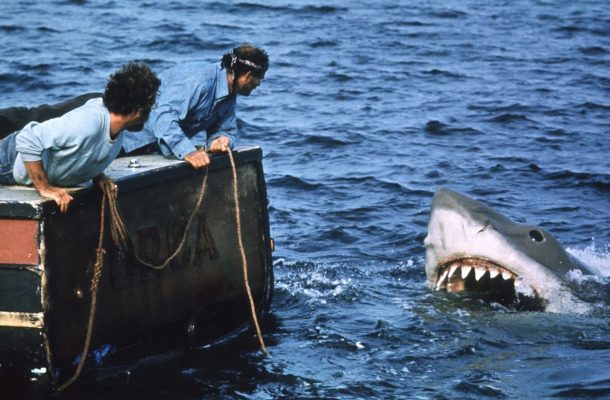Sharks v humans – Who’s the real predator?

“You’re gonna need a bigger boat.”
Sound familiar? It’s one of the most memorable movie lines, uttered by a terrified Martin Brody (Roy Scheider) as he backs away after sighting a great white shark in Steven Spielberg’s blockbuster movie Jaws.
It was 20 June, 1975, when the mechanical Hollywood construction resembling one of the ocean’s most notorious creatures made it to the silver screen.
Jaws turns 44 this year and while the movie depicts the shark as a menacing monster of the deep, Monash University researcher Associate Professor Richard Reina says they are more threatened by us than we are by them, and shark populations are in decline globally.
Associate Professor Reina, head of the Ecophysiology and Conservation Research Group in the School of Biological Sciences, is investigating the unintentional capture of sharks by recreational and commercial fisheries, and the consequences that has for their survival and ongoing health.
“Generally, the assumption has been if a captured shark goes back into the water alive, then everything is fine. But we now know that’s not true,” Associate Professor Reina says.
The biggest issue with incidental capture is that it puts enormous pressure on shark populations globally.
Upon capture, sharks experience the same kind of stress that you or I would experience if we were captured.
Research in 2018 discovered that large apex sharks such as hammerheads, tigers and great whites have declined by 74 to 94 per cent along the Queensland coast. And while there are various global estimates being made, many species are becoming depleted, with a high proportion at risk of extinction.
“What we want is to work out which shark species are most vulnerable and which are more resilient, so that we can have better management for each of those groups,” Associate Professor Reina says. “Then we can try to design ways that minimise the impact on shark populations because of commercial and recreational fisheries’ activity.”
Deeper dive
“Shark populations increase much more slowly than bony fish. Many sharks and rays have a live birth, are slow to mature, grow more slowly than other fish, reach maturity later, and they have fewer offspring,” he says. “These characteristics make populations less resistant to decline.”

For instance, the three-metre bronze whaler shark might give birth to a dozen or more pups, but it will be after a year-long gestation. While survival rates of individual pups might be better than the survival rate of fish larvae, even if all pups do survive, it nonetheless takes a long time for that population to recover.
There are species that are very sensitive to capture, such as hammerhead sharks, which use ‘ram ventilation’. According to Associate Professor Reina, they’re in real deep water.
That’s because these types of sharks swim with their mouths open, and the water flows over their gills to get their oxygen. They need to swim to breathe.
But what actually happens to sharks that are caught?
“Upon capture, sharks experience the same kind of stress that you or I would experience if we were captured,” he says. “They struggle, they fight, they burn through their energy reserves, they build up toxic by-products from that stress and struggling, and if they can’t breathe, then they go into oxygen starvation.”
And that stress continues for a long time after the initial capture.
Impact on the food chain
There are also profound ecological impacts, because nearly all shark species are top predators that sit at or near the top of the food chain.
Sharks eat various types of fish, but if shark numbers reduce and other fish increase, some of those fish can become predators, and may consume a commercially important fish species.
Understanding the impact of capturing sharks is key to identifying what ways they can be handled, processed and treated to minimise and prevent physiological and ecological damage.
Shifting our perceptions of sharks
“Public perceptions are important, too,” Associate Professor Reina says. “I think this is a hidden problem as well. A lot of people don’t know that shark populations are under threat worldwide because sharks get demonised in the media.
“It’s only a very small number of species that have these negative interactions with people. It’s under really limited circumstances, and it really gets hyped up by the media.”
“You’re more likely to hear that someone has been bitten when they’re surfing than to hear of shark declines.”
Are sharks the notoriously dangerous predators that we should be terrified of? He says no.
“It’s only a very small number of species that have these negative interactions with people. It’s under really limited circumstances, and it really gets hyped up by the media.”
A report by the CSIRO stated that while there’s been a rise in shark interactions, it’s because we are hanging out in their playground: the sea.
“Sharks have had a lot of bad press for a long time. A lot of people work now to get that perception shifted and change the way they’re presented,” he says.
He advises not to use the word “attack”, because it’s unlikely the shark intentionally attacked someone. Rather, it can be described as a shark bite, or an interaction with a shark.
“It’s about changing the way in which sharks are portrayed, and the way in which the risks are exaggerated and presented to people,” he says.
“If we can do that, people will start to care more about sharks and their future.”
This article was published by Lens.
Open Forum is a policy discussion website produced by Global Access Partners – Australia’s Institute for Active Policy. We welcome contributions and invite you to submit a blog to the editor and follow us on Twitter, Facebook, Linkedin and Mastadon.











